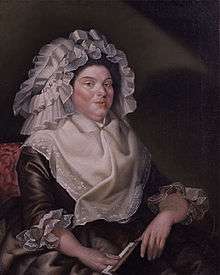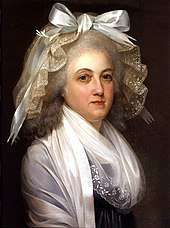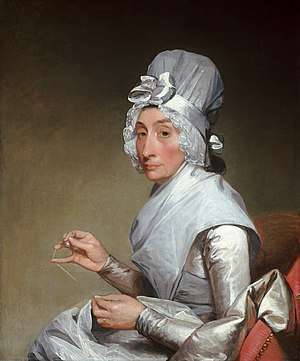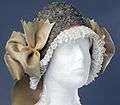Mobcap
A mobcap (or mob cap or mob-cap) is a round, gathered or pleated cloth (usually linen) bonnet consisting of a caul to cover the hair, a frilled or ruffled brim, and (often) a ribbon band, worn by married women in the Georgian period, when it was called a "bonnet". These caps were always gathered to a flat, often curved, brim. The caul had a flat bottom and curved top. The bottom was typically gathered to fit the back neck with a drawstring, while the curved sides and top were tightly gathered and stitched to the brim, which typically had some curves, too. Originally an informal style, the bonnet became a high-fashion item as part of the adoption of simple "country" clothing in the later 18th century. It was an indoor fashion, and was worn under a hat for outdoor wear.

Etymology
The origin of the term mobcap is a compound of mob 'dishabille, casually dressed' + cap. It may be modeled on Dutch mop(muts) 'woman's cap'.[1]
During the French Revolution, the name "mob cap" caught on because the poorer women who were involved in the riots wore them, but they had been in style for middle class and even aristocracy since the century began.
Variations
The one piece, ruffled, gathered circle mobcap often seen worn with historical costumes is a simplified, modern interpretation, rather than a copy of a period cap.
By the Victorian period, mobcaps lingered as the head covering of servants and nurses, and small mobcaps, not covering the hair, remained part of these uniforms into the early 20th century.
Modern versions of mobcaps are still worn in the pharmaceutical industry, in clean-rooms, and in other sectors where the hair has to be contained. These mobcaps are usually a simple circle shape with an elastic band and may be made of disposable materials such as spun-bound polypropylene so they are like a shower cap. They can also be made of nylon netting.
Gallery
 A portrait of an unidentified woman sporting a fabulous mobcap by the English landscape and portrait painter, Joseph Wright of Derby
A portrait of an unidentified woman sporting a fabulous mobcap by the English landscape and portrait painter, Joseph Wright of Derby 1789
1789 Marie Antoinette c. 1792
Marie Antoinette c. 1792 1793
1793 James Jacques Joseph Tissot's Man, Woman, and Map, which features a mobcap
James Jacques Joseph Tissot's Man, Woman, and Map, which features a mobcap A portrait of Mrs. Herman Henry Schroeder (the former Suzannah Schwartz) by Charles Peale Polk, which was completed in about 1794
A portrait of Mrs. Herman Henry Schroeder (the former Suzannah Schwartz) by Charles Peale Polk, which was completed in about 1794 Mobcap with gold brocade, gold lace and sequins worn by wealthy ladies in Żywiec, Poland
Mobcap with gold brocade, gold lace and sequins worn by wealthy ladies in Żywiec, Poland
References
- Merriam-Webster, Merriam-Webster's Unabridged Dictionary, Merriam-Webster.
